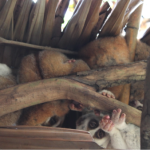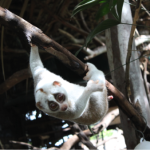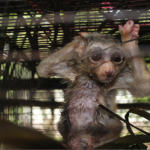By Stephanie Poindexter
I have been I have been mesmerized by the physical agility of primates for as long as I can remember. As a primate lover himself my dad and I would make regular trips to the Brookfield Zoo in Chicago, to watch all of the crazy way primates could twist and turn their bodies. Since those days at the zoo I have spent hours watching chimpanzees, spider monkeys, capuchins, marmosets, and tamarins, but over the last year I was lucky enough to fall in love with a new group of primates called lorises.
Much like the monkeys and apes I watched with my dad, lorises can contort their bodies in unique ways, which helps them move through the forest and reach for things they need. Unfortunately in some captive environments their wide range of postures can become limited and as a personal fan of how primates use their bodies, I enjoy looking for ways to restore and maintain this range.
During my MSc in Primate Conservation at Oxford Brookes University, I decided to further look at the effects of gum-based enrichment on promoting natural postures in rescued slow lorises. After multiple meeting with Anna Nekaris and 8 months of planning, I finally made the long 30-hour journey from Chicago to Bangkok. Nancy Gibson, the founder of Love Wildlife Foundation in Thailand graciously allowed me to study the three species of slow lorises she helps to manage at a rescue center in Bang Phra, Thailand.
Before I knew it 3 months of nightly observations had passed by and I had results! I found that introducing various gum-based enrichments in addition to having a well-designed enclosure could be used to promote natural postures and behaviors. While I was very excited to see some of those “lost” postures resurface, I wondered how this contributed to alleviating the greater issues plaguing slow lorises?
In Thailand slow lorises are popular pets and are frequently paraded as photo props in popular tourist areas. Knowing little about the special needs of these cryptic primates, private owners are rarely able to provide proper care. By the time these ex-pets and photo props get to rescue centers they can be in pretty bad shape. Creating environments and scenarios similar to the ones they have evolved to survive helps to maintain their “lorisy” specializations.
While I spent most nights watching the lorises, I found time during the day to observe their preference between enclosure sleeping site options. During 2 of 3 months I checked to see where each loris decided to sleep during the day. Having many nest box options and branch options, almost all of the slow lorises picked branches.
The number of slow lorises arriving in rescue and government confiscation centers continues to grow. Studying the ways that various aspects of captivity affects the individual and group wellbeing needs more attention and I hope that my research can contribute to helping captive lorises live long healthy lives.

Group of rescued slow lorises sleeping together in branches.

Bengal slow lorises pausing during suspensory walking.

Bengal slow loris upon arrival at a rescue center in Thailand.



